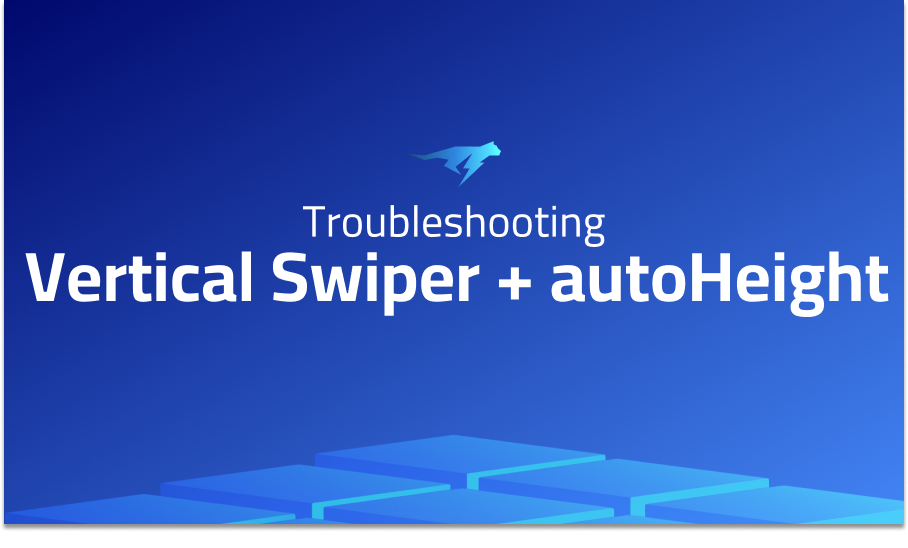

Vertical Swiper + autoHeight
Explanation of the problem
The request highlights a problem related to vertical sliders in Swiper, where the autoHeight feature does not work when the slider’s direction is set to ‘vertical’. The desired solution entails having a swiper that functions similarly to the autoHeight mode in horizontal sliders. Specifically, it should measure the height of the current slide (or the highest slide if multiple are present) and adjust the wrapper height accordingly. The request seeks to enhance Swiper by enabling the autoHeight functionality for vertical sliders, providing a more versatile and convenient solution for various use cases.
Regarding alternatives, the request acknowledges that fixed height sliders can be effective when using the vertical mode, but it may not always be the optimal solution. The need for an autoHeight feature arises from scenarios where the content within each slide dynamically determines its height. This approach allows for a more flexible and adaptive slider that can accommodate varying content heights. Exploring alternatives to achieve the desired functionality, such as custom CSS, JavaScript, and event handling, was attempted. However, finding the appropriate event and code combination to accurately calculate the height proved challenging. Despite the difficulties, the request expresses a strong belief that combining autoHeight with the ‘vertical’ direction would result in a highly compatible and desirable combination.
In the provided context, @nolimits4web mentioned that the autoHeight feature is currently only available for the ‘horizontal’ direction. The reason behind this limitation is not explicitly stated. The request seeks clarification on the rationale for this restriction, perhaps to better understand any technical or design considerations associated with enabling autoHeight for ‘vertical’ sliders. To illustrate the issue and the attempted workaround, a CodeSandbox example was shared. Although the example successfully adjusts the wrapper height, it encounters difficulties with the slide offset. The request concludes by expressing appreciation for any guidance or workaround suggestions that can help achieve the desired functionality of combining autoHeight with the ‘vertical’ direction in Swipe.
Troubleshooting with the Lightrun Developer Observability Platform
Getting a sense of what’s actually happening inside a live application is a frustrating experience, one that relies mostly on querying and observing whatever logs were written during development.
Lightrun is a Developer Observability Platform, allowing developers to add telemetry to live applications in real-time, on-demand, and right from the IDE.
- Instantly add logs to, set metrics in, and take snapshots of live applications
- Insights delivered straight to your IDE or CLI
- Works where you do: dev, QA, staging, CI/CD, and production
Start for free today
Problem solution for Vertical Swiper + autoHeight
In the first answer, a solution was proposed that demonstrated effectiveness in addressing the issue. The provided CodePen example serves as a reference for implementing the suggested approach. However, it is important to note that this solution may not be compatible with the loop:true configuration. Careful consideration should be given to the project’s requirements and limitations before adopting this approach.
Alternatively, the second answer showcases a different solution where the Swiper library was replaced with Slick Slider. This decision was motivated by the observation that Slick Slider better met the project’s needs, particularly in terms of vertical navigation functionality. Although Slick Slider may not possess the same level of feature richness as Swiper, it was deemed sufficient for achieving the desired outcome.
By emphasizing the importance of exploring various options, developers can carefully evaluate the trade-offs and functionalities associated with each solution. This process allows for a deeper understanding of the problem at hand and enables the selection of the most suitable solution. It is recommended to consider the specific requirements, limitations, and goals of the project before making a decision, ensuring that the chosen approach aligns well with the desired outcome. Through diligent evaluation and experimentation, developers can find the optimal solution that meets their needs while providing a reliable and effective solution to the identified issue.
Other popular problems with nolimits4web Swiper
Problem: Initialization Issue
One common issue with nolimits4web Swiper is that the component may not initialize properly, leading to unexpected behavior. This can occur when the component is rendered before the required data is available or when the Swiper library is not imported correctly.
Solution:
To resolve this issue, it is important to ensure that the Swiper library is imported correctly and that the component is only rendered when the required data is available. This can be achieved by using a conditional statement that only renders the component when the data has been loaded, or by using the useEffect hook to wait for the data to be loaded before rendering the component.
Problem: Navigation Problem
Another common issue with nolimits4web Swiper is that the navigation buttons may not work as expected. This can be caused by incorrect implementation of the navigation options or by the presence of conflicting CSS styles.
Solution:
To resolve this issue, it is important to ensure that the navigation options are implemented correctly and that any conflicting CSS styles are removed. This can be achieved by reviewing the code and removing any conflicting styles, or by consulting the Swiper documentation for correct implementation of the navigation options.
Problem: Performance Issues
Performance issues are a common problem with nolimits4web Swiper, particularly when large amounts of data are being displayed. This can result in slow loading times and a negative user experience.
Solution:
To resolve this issue, it is important to optimize the data that is being displayed and to ensure that the component is optimized for performance. This can be achieved by reducing the amount of data being displayed, by using lazy loading, or by using virtualization to only render the data that is currently visible on the screen. Additionally, it may be necessary to optimize the component’s code to ensure that it runs efficiently.
A brief introduction to nolimits4web Swiper
nolimits4web Swiper is a popular and feature-rich JavaScript library for creating touch-enabled slider and carousel components for modern web applications. It is built using native HTML, CSS, and JavaScript, and does not require any external dependencies. The library has a flexible and modular architecture that allows for customizing and extending the core functionality to meet specific needs.
Swiper supports various touch gestures and mouse events, including swipe, drag, and click, which makes it highly responsive and user-friendly. It provides a range of customization options, including slides per view, looping, pagination, navigation buttons, scrollbar, autoplay, and more. Additionally, the library is optimized for performance and has been tested on a variety of devices and browsers, ensuring a smooth and consistent experience for end-users. Swiper can be easily integrated into any web project and is compatible with popular frameworks such as React, Angular, and Vue.
Most popular use cases for nolimits4web Swiper
- Nolimits4web Swiper is a mobile-first, touch-enabled JavaScript library that can be used for creating flexible, responsive, and touch-friendly slideshows and carousels.
- It allows developers to implement various customization options, such as navigation buttons, pagination, loop mode, autoplay, and mousewheel control, among others. This provides a rich user experience for users and a high level of control for developers.
- Nolimits4web Swiper integrates seamlessly with a wide range of web technologies and frameworks, including Angular, React, Vue, and more. A code block demonstrating its usage in a simple HTML page might look like this:
<div class="swiper-container">
<div class="swiper-wrapper">
<div class="swiper-slide">Slide 1</div>
<div class="swiper-slide">Slide 2</div>
<div class="swiper-slide">Slide 3</div>
</div>
<!-- Add Pagination -->
<div class="swiper-pagination"></div>
<!-- Add Arrows -->
<div class="swiper-button-next"></div>
<div class="swiper-button-prev"></div>
</div>
<script>
var swiper = new Swiper('.swiper-container', {
pagination: {
el: '.swiper-pagination',
},
navigation: {
nextEl: '.swiper-button-next',
prevEl: '.swiper-button-prev',
},
});
</script>
It’s Really not that Complicated.
You can actually understand what’s going on inside your live applications.




